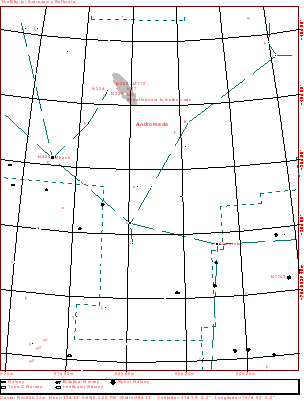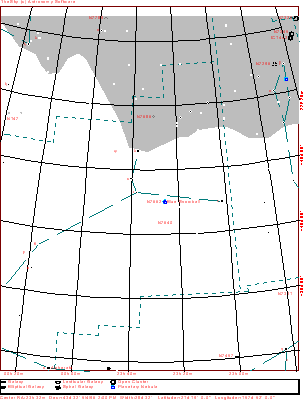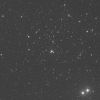
| Home | Deepsky Atlas | TheAstronews | Links | Solar System | ||||||

Hawaiian Astronomical SocietyConstellations: Andromeda -- Daughter of Cassiopeia |
||||||||||
Cassiopeia, the mother of Andromeda and wife of King Cepheus of Ethiopia, thought she and her daughter were the two fairest that ever lived. In fact, she foolishly claimed that Andromeda was so beautiful that even the sea nymphs (Nereids) could not surpass her beauty. Hera, Zeus' jealous wife, and the Nereids themselves, overheard this. Furious at Cassiopeia's boasting, they visited Poseidon (the sea god) and demanded an immediate punishment.
Poseidon sent the sea monster Tiamat (represented by Cetus) to attack King Cepheus' realm. With his kingdom in the gravest danger, Cepheus consulted an oracle for advice. He learned the only way to save Ethiopia involved the sacrifice of Andromeda to the raging sea monster. Heavy hearted and bitter over his wife's vanity, the king was forced by his people to comply. Poor Andromeda was dragged to a ragged part of the coast and was told of her fate.
She was stripped naked and chained to a large rock to await her grisly fate. The monster soon arrived. Tiamat was about to eat her, when the monster felt a sharp pain in his back. He turned and found Perseus flying with winged sandals and attacking him. The monster grew stronger as they fought. Then Perseus remembered that he was carrying Medusa's head. All who looked at it would turn to stone. He dropped his sword and took out the creepy object. The sea monster stared at it and turned immediately into stone. Andromeda watched the whole incident (except Medusa's head), and smiled with a sigh of relief.
Perseus fell in love with the beautiful Andromeda and carried her home to marry her. The gods made constellations for each of them, but felt Cassiopeia had gotten off too easy. They punished her by condemning her to circle Polaris forever in her throne. So even now, she alternately sits right side up and hangs upside down in the heavens. Of course, in Hawaii, Cassiopeia sets.

Click the map for a 909x1199 version of the above. Click here for a map better suited for use in the field.

This is the north-east section of the constellation. The map displays stars to magnitude 10, and deepsky objects to magnitude 12. Click here for a map better suited for use in the field.

Click here for a map better suited for use in the field.

Click here for a map better suited for use in the field.
 NGC7662 (Best 2, Caldwell 22) is a planetary nebula called the Blue Snowball. Drawing a line 13° due north of the top, center of the Great Square of Pegasus, you then move 2.3° WSW from Iota Andromedae. Considered a remarkable object by Dreyer (he gave it a triple exclamation point), he calls it very bright (mag. 9), small (size estimates range from a diameter of .2' to 5'), round, and blue. Other observers add that size and detail increases with the addition of high power (200x or higher). From a drawing made by Scott Davis. NGC7662 (Best 2, Caldwell 22) is a planetary nebula called the Blue Snowball. Drawing a line 13° due north of the top, center of the Great Square of Pegasus, you then move 2.3° WSW from Iota Andromedae. Considered a remarkable object by Dreyer (he gave it a triple exclamation point), he calls it very bright (mag. 9), small (size estimates range from a diameter of .2' to 5'), round, and blue. Other observers add that size and detail increases with the addition of high power (200x or higher). From a drawing made by Scott Davis.
|
The Andromeda Galaxy M31 (NGC224) Object type: Spiral Galaxy
Distance from Earth: 2,500,000 light years / 77,000 parsecs
Distance across galaxy: 160,000 light years
The Great Galaxy in Andromeda is the largest galaxy in the Local Group which includes our Galaxy, the Milky Way. M31 contains over 300 billion suns. We see it nearly edge on - from our viewpoint it is tilted at an angle of 13°. It is the farthest object visible to the naked eye. M31 can be seen without optical aid from sites away from city lights when the Moon is below the horizon. With a telescope, the two satellite galaxies NGC205 and M32 can be seen in the same field (and are shown in the picture immediately below at left center and bottom right).
|
 88k JPEG A wide angle view of the galaxy. Image by Jerry Lodriguss, used with permission. 88k JPEG A wide angle view of the galaxy. Image by Jerry Lodriguss, used with permission.
|
 M32 (NGC221), in a 393x390 close-up of M31's compact companion. When looking at the center of M31 with an eyepiece field of 1° or greater, you will see two small fuzzy patches. On is faint and shows little condensation. This is NGC 205, sometimes called M110, although Messier never listed it. The other companion, seemingly embedded directly in the nebulosity of M31 itself, and far more condensed, is M32. M32 shines at mag. 9 and covers 9'x7' of sky. M32 (NGC221), in a 393x390 close-up of M31's compact companion. When looking at the center of M31 with an eyepiece field of 1° or greater, you will see two small fuzzy patches. On is faint and shows little condensation. This is NGC 205, sometimes called M110, although Messier never listed it. The other companion, seemingly embedded directly in the nebulosity of M31 itself, and far more condensed, is M32. M32 shines at mag. 9 and covers 9'x7' of sky.
|
 45k JPEG M110 (NGC205) is the fainter, more diffuse companion galaxy to M31, lying just to M31's north. It shines at mag. 8.9, and covers 22'x9'. Image from SEDS. 45k JPEG M110 (NGC205) is the fainter, more diffuse companion galaxy to M31, lying just to M31's north. It shines at mag. 8.9, and covers 22'x9'. Image from SEDS.
|
 78k JPEG NGC752 (Caldwell 28) is an open cluster located 4.8° SSW of Almach (Gamma Andromedae) it contains a loose assemblage of 70 mag 8 stars and fainter. Dreyer speaks of it having both "large" and "small" stars. With a total magnitude of 5.7, and a size of 50', this is a good finder, or binocular object. Large Dobsonians may notice many faint mag. 15+ galaxies throughout the area. One "bright" (at mag. 13.1) exception is IC179 at the top, left of the photo. From the Digital Sky Survey. 78k JPEG NGC752 (Caldwell 28) is an open cluster located 4.8° SSW of Almach (Gamma Andromedae) it contains a loose assemblage of 70 mag 8 stars and fainter. Dreyer speaks of it having both "large" and "small" stars. With a total magnitude of 5.7, and a size of 50', this is a good finder, or binocular object. Large Dobsonians may notice many faint mag. 15+ galaxies throughout the area. One "bright" (at mag. 13.1) exception is IC179 at the top, left of the photo. From the Digital Sky Survey.
|
 42k JPEG NGC891 (Best 1, Caldwell 23) is the other bright galaxy in Andromeda. Located 3.4° east of Almach (Gamma Andromedae) it lies edge on (14'x2')and shines at mag. 10. It also makes a good starting point for a galaxy hop eastward towards Perseus. 42k JPEG NGC891 (Best 1, Caldwell 23) is the other bright galaxy in Andromeda. Located 3.4° east of Almach (Gamma Andromedae) it lies edge on (14'x2')and shines at mag. 10. It also makes a good starting point for a galaxy hop eastward towards Perseus.
|
 110k labeled JPEG. NGC1023 (Best 81) is an eliptical galaxy located on the Andromeda border in Perseus, 3.75° south of M34. The Dreyer description reads very bright (mag. 10.3), very large (8.7'x3'), very much elongated (in p.a. 87°), with extreme brightening toward the middle. Steve Coe reports a "tuft" (NGC1023A) on the east side when viewing it with a 13". 110k labeled JPEG. NGC1023 (Best 81) is an eliptical galaxy located on the Andromeda border in Perseus, 3.75° south of M34. The Dreyer description reads very bright (mag. 10.3), very large (8.7'x3'), very much elongated (in p.a. 87°), with extreme brightening toward the middle. Steve Coe reports a "tuft" (NGC1023A) on the east side when viewing it with a 13".
Other galaxies inhabit the Digital Sky Survey image, most notable being the spiral IC239 (46' west of NGC1023 and in Andromeda proper), shining at a very faint mag. 11.7 and covering 4.6'x4.2' of sky.
|
If you have any questions about the Hawaiian Astronomical Society
please
(link requires javascript).